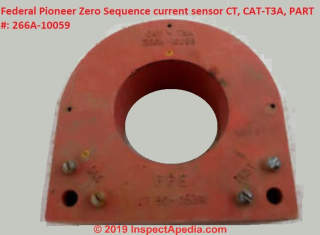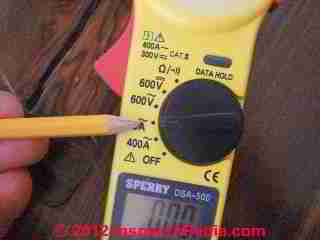 Electrical System Repair Q&A-5
Electrical System Repair Q&A-5
FAQs install repair electrical wiring & equipment
- POST a QUESTION or COMMENT about building electrical systems, panels, breakers, wiring installation, inspection, diagnosis, & repair
Set #5 - Q&A - on how to install, inspect, & troubleshoot building electrical systems, appliances, components.
This article series provides detailed inspection, troubleshooting, & repair information for building electrical systems and equipment including electrical service entry, electrical wiring, appliances, motors, receptacles, switches, lights, etc.
InspectAPedia tolerates no conflicts of interest. We have no relationship with advertisers, products, or services discussed at this website.
- Daniel Friedman, Publisher/Editor/Author - See WHO ARE WE?
Building Electrical System FAQs-5
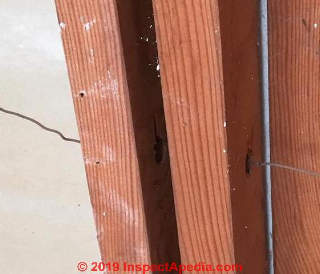 These questions & answers about building electrical systems, wiring, & components were posted originally
These questions & answers about building electrical systems, wiring, & components were posted originally
at ELECTRICAL INSPECTION, DIAGNOSIS, REPAIR - home - be sure to see the suggestions at that page.
[Click to enlarge any image]
On 2020-03-21 by Anonymous - ok to fix a bent electrical masthead?
Anon:
You may be able to repair a bent masthead - presumably a pipe - but the procedure is VERY dangerous as unless you have the electric power company drop power to the home you are likely to be killed by electrocution.
Also you'd want to know why the masthead bent; it may be inadequate and need replaement.
You don't give your country and city but in most jurisdictions any new electrical work must be done to current codes, not 1961 electrical codes.
On 2020-03-21 by Anonymous
Does 1961 code apply to a 1961 house if I repair rather than replace the mast head? Or does current code override 1961 code for repair?
On 2020-03-21 by LaVonia
I have a 1961 house. Can I repair a bent electrical mast head by straigntening it and adding re-inforcement, instead of replacing it?
On 2020-03-19 - by (mod) - no power to outlet and do not know where it comes from
Joe
Some help on tracing and identifying electrical circuits and their wiring is at
ELECTRICAL CIRCUIT ID, MAP & LABEL
On 2020-03-19 by joe
no power to outlet and do not know where it comes from
On 2019-12-04 by (mod) - recognize improper extensions of or splices into old knob and tube wiring
That's an interesting observation. I haven't seen knob and tube that Wilson fabric insulated but that doesn't mean it couldn't exist. In some jurisdictions including New York City knob and tube was legal until so recently that an electrician may have found a single conductor that was rated to be used exposed as a single conductor
Follow the wires back to see if you can find a connection to Modern plastic insulated wire at a source. That might be a clue.
On 2019-12-03 by Bruce Jaenke
I am working on replacing some light fixtures in my daughter's house and was inspecting some of the wiring. It is definitely knob and tube, but the insulation looks like modern PVC. Is this possible? I thought all knob and tube had cloth insulation.
Also, the wire colors are white (neutral), black (line), blue (switch hot), and green (ground - bathroom).
Everything I have read says that knob and tube is only black and white and has no ground. So, I'm just trying to figure out what is going on. All the wiring looks original to the house, no evidence of any DIYs or anything. The house was built either in the 1950s or 1960s. Any insight would be helpful.
On 2019-11-28 by (mod) - Federal Pioneer Zero Sequence current sensor CT, CAT-T3A,
Sorry, Lena, but no.
For other readers, quora.com explains
The CT ratio is the ratio of primary current input to secondary current output at full load. ... Current transformers, or CTs, are transformers used to step down the current level of high-power transmission systems to measure or monitor the current levels.
Read about a current version of a product similar to the older Federal Pioneer Zero Sequence current sensor CT, CAT-T3A, PART #: 266A-10059
at
CT-11: FPL ZERO-SEQUENCE SENSORS WITH LITTELFUSE RELAYS [PDF] (2018) from Littlefues Startco original source m.littelfuse.com/~/media/protection-relays/technical-notes/tn-ct11-fpl-zero-sequence-sensors-with-littelfuse-relays.pdf
download at InspectApedia.com at
inspectapedia.com/fpe/Federal-Pioneer-Zero-Sequence-Sensor.pdf
However it should be a trivial exercise to use a suitable ammeter to measure the current ratios when your device is under a normal load.
Those details are at AMPS MEASUREMENT METHODS
An image of the Federal Pioneer Zero Sequence current sensor CT, CAT-T3A, PART #: 266A-10059 as sold on eBay is shown below
Also see FPE Stab-Lok® : FIRES WAITING TO HAPPEN
On 2019-11-25 by Lena
We have a FPE zero sequence CT, CAT-T3A, PART #: 266A-10059. There is no CT ratio on the CT. So could you please provide this CT ratio?
Thanks
Lena
On 2019-11-09 by (mod) - 1000 Watt electric heater on a 120V circuit is going to draw about 8.3 Amps.
Diego:
A 1000 Watt electric heater on a 120V circuit is going to draw about 8.3 Amps.
Unless you're running more high-amp usage devices on the same circuit you ought to be able to plug an electric heater into the 15A branch circuit serving a room PROVIDED that that circuit is NOT serving multiple rooms and multiple heaters. (Often the bedroom receptacles are all on 1 circuit - depending on age, country and city of the home)
Else yeah you want dedicated circuit(s).
A dedicated circuit to run 1 heater (depending on how far the wires run) could be a 15A (#14 copper) 120V circuit but you couldn't run two heaters on that circuit as you'd overload it.
A dedicated 20A circuit could run 2 such heaters, run into a common wall between two rooms so that one electrical box or a pair of them served by just that one circuit could run the two heaters;
(2 x 8.3A) = 16.6 A and thus still below the 20A that a #12 copper 20A 120VAC circuit (and breaker) can provide.
If your licensed electrician (who can probably the work safer, quicker, legally, and without burning down the house or killing someone) were to run instead a 220V circuit (that's going to be a 3 wire circuit, 2 hots and 1 ground) she or he could run a 15A 220V circuit because
each of those 1000 W heaters, if in a 220V model, would draw just 4.5 Amps
(3 x 4.5 = 13.5A)
If I were doing it I'd run a 20A 220V circuit to a common point from which I could split off short runs to the bath and to the 2 bedrooms - IF the layout of the house makes that feasible.
Remember that where you live it may be that you're required to have the work done by a licensed electrician. IF not you probably still need a permit and inspections by your local electrical or fire inspector - view that as a benefit not a hassle as those inspections are to keep you safe.
On 2019-11-08 by Diego
I need to install three wall heaters in my house. My breaker panel is in the garage and I want to install 2 wall heaters inside 2 bedrooms and one heater inside the bathroom.
The bathroom and the bedroom are in the second floor. Should I run one wire for each wall heater with his dedicate breaker? Or there is another option to run the wire/breakers ?
I am thinking to install three heater of 1000 whats each one. Should I buy 120v heaters or 220v heaters.
Thank you so much for all the information.
On 2019-09-26 by (mod) -
Berk
I see sub-meters sold for electrical power usage monitoring but I've not come across two inline with transfer switch metering; let's start by a call to your local electrical utility and electrical inspector. Let me know what they say.
On 2019-09-26 by berkly
Question. Any one know of electrical codes that prohibits two electrical meters inline? separated by disconnect and transfer switch.
On 2019-09-21 by (mod) - electricity meter outside our home has no door
It sounds as if your meter is missing a part and is open to the weather. That's extremely dangerous not only because of the risk of water getting in but because some fool can stick a finger in there and get electrocuted. You should hire an electrician to make the necessary repair. It may be that the electrician will need to get a new meter Mount from The Electric Company.
On 2019-09-19 by Stressedout
I have a concern. Our electricity meter outside our home has no door and is exposed to possible tampering and possible rain water getting into the electrics. The meter is owned by NPower who was dismissive and said it was the duty of our local council to safeguard the wiring and to prevent possible adverse wet weather from getting into the electrics.
We were alarmed to be told this at the close of normal business hours, despite not owning or living in rented council property. One of the adults in our home is disabled and vulnerable. Npower said that all electrotyping meters don’t come with doors and most people have to buy them. If possible water was to get into the electrics is it a concern for anyone or something in our imaginations? any advice would be appreciated
On 2019-09-14 by (mod) -
Also see this
NAVEDTRA BLUEPRINT READING GUIDE available here at https://inspectapedia.com/electric/NAVEDTRA-14040A-Blueprint-Reading-and-Sketching-Part-2.pdf
Original source: https://seabeemagazine.navylive.dodlive.mil/files/2017/11/NAVEDTRA-14040A-Blueprint-Reading-and-Sketching-Part-2.pdf
On 2018-06-24 by (mod) - my wife and I both hear a high pitched noise or "ringing in the ears"
Seems odd indeed but certainly shutting off electrical power eliminates your in-home electrical service from the panel onwards as the noise source.
With power off, even poor grounding ought not be a noise source.
There are quite a few sources of ringing shrieking noises in buildings
See ARTICLE INDEX to BUILDING NOISE DIAGNOSIS
for some suggestions. There we've cataloged noises by type or description.
On 2018-06-24 by jaylloyd
While in our house, (and only there), my wife and I both hear a high pitched noise or "ringing in the ears". We have shut off the service to the power meter to eliminate any electrical "feedback" such as ballasts. Also we shut off any wi-fi and bluetooth devices, but the noise continues. I've been told "Maybe your house wiring could be acting as an antenna". Could a poor ground cause this? What do you think I need to do to correct this.
On 2017-04-15 by (mod) -
Likely cause - where we start anyway - is a worn receptacle and loose, wobbly or perhaps even corroded contacts in the receptacle.
It would be odd for voltage to vary so much (120VAC down to 88) from the actual supply source.
But when you replaced the receptacle and get the same results I agree that we need to look further.
1. does your home use aluminum electrical wiring? If so there are fire hazards to be addressed.
2. You may need an electrician to review the service entry wiring and electric meter and main panel connections for poor connections, shorts to ground, improper neutral or ground wiring.
Improper wiring, shorts, might show up as a voltage drop when a load is applied to the circuit. (OPINION - and arm-waving speculation but I've seen it)
Watch out: these conditions are unsafe and represent both fire and shock hazards.
On 2017-04-15 by Ken
In a mobile home I read 120vac at an outlet.Then when I plug something in it will not work.So I unplug and measure again now 88vac.I replaced outlet and same two steps get same results.Likeley cause?
On 2016-05-14 by (mod) - I don't know where to hook up electrcial wires for a heater
Dan,
I appreciate (by your repeated entries now deleted) that you're perhaps frustrated or angry that you don't know where to connect electrical wires in an electrical heater.
Please understand that as editor / moderator I'm reluctant to see you get shocked or killed through the possible mistake of guessing at what's needed and giving that advice to someone who may not know how to handle electrical siring safely. A mistake can burn down the house, burn up the heater, and kill someone. So please be careful, and use expert help or a repair service if that's what's appropriate.
Heat Wave produces a 1500-Watt 6-element quartz heater, a portable unit that's widely sold. (I don't know this heater directly). Beware that some electric heaters billed as infra-red are not. This heater, as packaged and displayed at Amazon is described as a "ceramic heater".
Watch out: I see a number of these heaters listed as "refurbished" that suggests that you're not the only one having trouble with the product. Depending on the nature of the trouble, the device may well be unsafe.
I can see why you're asking us: I've had a heck of a time even finding out who actually makes this Heater "brand" and model. If we can find the manufacturer it should be trivial to ask for the heater's wiring diagram and specifications. I searched for Heat Wave 1500-6 (finding used refurbished) and Heat Wave Barrington and other suffix-names (at Walmart).
Making matters worse, a number of vendors use the term "heat wave" for heaters that may not be made by the same manufacturer, such as TPI Corporation who sell a range of salamanders and other electric heaters, or "Made in the Philipines" or possibly made in China.
Frankly, I'm nervous about even the idea of trying to fix and use such a mysterious device.
On 2016-05-14 by Dan
I-need-to-no-where-wires-go-to-on-the-inside-of-a-heat-wave-2-electrical-heater-model-number-1500-6. 240-volt-single-phase-5750-wattage.
On 2019-06-19 by (mod) -
Sorry I don't understand the question.
In general: an electrician would connect hot-to hot (usually black wire) and neutral to neutral (usually white); she'd test the wires as well as trace them from their source to solve any confusion about which wire was used for which purpose.
Watch out: if you're not familiar with proper electrical wiring you could make a mistake that gets you killed or burns down the house.
On 2019-06-17 by James
No the wires are already easily accessible im just not sure how exactly they recconect because of the red wire arent they isnt it white with wh and black with black wherre does the red one go
How would i go about reconnecting a electrical wire in a mobile home if one side of the damaged wire has a red black and white and copper and the other side just has the black and white with the copper
How do you reconnect wires that were cut on half when one side has red black white and copper and the other side only has white black and copper
On 2019-06-11 by (mod) -
I hope you turned that circuit off to avoid a fire or shock injury or worse. I can't tell the cause from just your brief text.
On 2019-06-10 by wernermark827
Cloth wire and metal box arcs when you touch with the tester
On 2019-05-16 by (mod) -
Sandra
Elsewhere we had this question and, if I recall right, I suggested that your electrician needs to use a circuit tracer to follow the wires. Somewhere early in the circuit she's going to find an open wire. Rather than removing the floor, if there's safe access below the doublewide - as there should be, I'd inspect from that side first.
On 2019-05-10 14:50:51.646173 by sandra mahan
I have a 1980 celtic doublewide and I had plywood put down in bedroom and lost power to lights in one side of mobile home. I have had 2 electricians her that cannot locate where the problem is. One electrician said to remove floor that maybe a wire got cut when it was put down, but are there wires in the floor? he thinks it is w
2 outlets in same wall and that a white wire is problem, but if outlets are in wall, why remove floor? than you
On 2019-04-11 23:31:47.718368 by (mod) -
While you're waiting for help to trace the circuit when I go to the panel and simply turn that circuit off. That would be the safest thing to do when you're concerned about an electrical fire. Also tell me the brand of the electric panel as I may have additional comments.
On 2019-04-11 by Jesse Garcia
I own a Saturn Double Wide four br mobile home bought in 1999. I have lost power to the master Bathroom. closet adjenct to bathroom and a guest bedroom next to master bedroom. Have checked all outlets and overhead cross connects and am unable to locate problem. Need help. Worried about electrical fire.
On 2019-02-27 by (mod) -
The question John, thank you.
With the warning that no one can assess the safety of your electrical system by a website page comment, I will suggest there could be several reasons that you might want to upgrade the electric panel in a 1950s home.
First the brand of panel maybe one that is known to be a problem or unsafe such as FPE or some others.
2nd the total amount of electrical current from all of the devices that you run in a home in 2019 may be a challenge for a smaller older capacity electrical panel that was perfectly adequate in the 1950s 60s and even 1970s.
3rd your panel itself may be damaged buy moisture condensation leaks or previous electrical events. Cuz you're all things that a licensed electrician can inspect and advised about.
On the other hand 100 amps is probably perfectly fine even today for a small home with very modest electrical usage.
On 2019-02-26 by John
The home my wife grew up in was built in 1956. The home is in Florida and has service from Florida Power and Light (100 amp service). Is there any reason that service should be upgraded?
On 2019-02-04 by (mod) - And then my electric went out in my kitchen
what you describe certainly raises a safety and fire concern. For example it's possible that a wet electrical component ultimately led to I burn up or the opening of a connection that leaves the circuit off.
On 2019-02-03 by Holly
Yes I had a outlet underneath the trailer and I think water got in it and it popped my fuse and now when I put a new fuse in it keeps popping so I unscrewed it and then my electric went out in my living room and my one bedroom.
And then my electric went out in my kitchen today and I put a new fuse in and it still won't come on in the fuse didn't pop
On 2019-01-06 by (mod) - original DC voltage levels in antique electrical systems
Bruce
Details of some of the earliest DC electrical wiring we've found (Edison DC cabling) are
at SOLID PIPE EDISON DC CABLE HISTORY
There and also at OLD ELECTRICAL WIRING TYPES you'll see both a discussion of and links to PDF files giving details about Edison's views on the appropriate DC voltage level to be used as well as its safety.
Take a look and feel free to post further comments or questions there or here.
Thanks for an interesting question.
On 2019-01-06 by Bruce Frederickson
I recently built a model of an English mansion which was built in Saskatchewan Canada in approximately 1910.
The house had knob and tube wiring and was powered by a windmill and batteries I assume.
Trying to
track down the likely DC voltage used, I am under the impression that it was a 32 vdc system. Would this sound reasonable?
Does anybody have any ideas?
Thanks
On 2018-07-19 by (mod) - What is a load controller and how do they work?
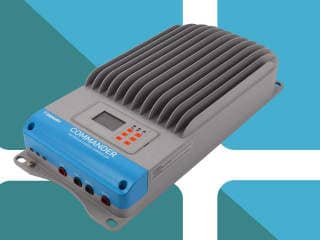 Vince
Vince
The term "load controller" is a bit broad, and I was not able to find Claw Industries as a supplier of electrical load controllers - still looking.
Please use the "add image" button to show us (one per comment) photos of the device, whatever you can see of its wiring, and good photos of its labeling and I can give a more exact answer.
Meanwhile I am left GUESSING:
A rather specialized load controller used with solar systems is the RENOGY 60A Maximum Power Point Tracking Solar Charge Controller - described by the company (Renology in Ontario) as follows:
The RENOGY Commander MPPT controller is suitable for off-grid solar applications. It protects the battery from being over-charged by the solar modules and over-discharged by the loads. The controller features a smart tracking algorithm that maximizes the energy from the solar PV module(s) and charge the battery. - Renology Commander Series
- Commander Series RENOGY 60A Maximum Power Point Tracking Solar Charge Controller Manual [PDF], Renology, 2775 E. Philadelphia St., Ontario CA 91761 Tel: 1-800-330-8678, Website: www.renology.com - retrieved 2018/07/19, original source: https://www.renogy.com/template/files/Manuals/CTRL-CMD60.pdf
OR for heavier duty electrical loads, and again IF your Star Commander is an Electrical Load Controller it may be working as follows:
This type of electrical load controller attempts to reduce electricity costs (often part of a "smart home" set-up to conserve energy) by monitoring electrical power usage in the home and by certain high-usage appliances, then adjusting power levels and usage during periods of peak demand to reduce electrical usage and thus costs.
For example a load controller might turn off or turn down an electric water heater at certain times.
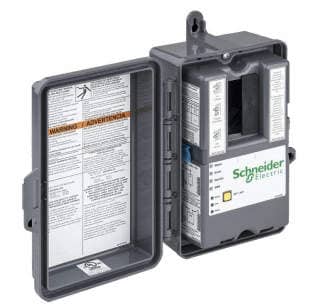 The controller might manage load by reducing voltage when that's permitted (without harming the appliance) or by introducing a turn-on delay such as slightly delaying the start-up of an air conditioner in response to a thermostat.
The controller might manage load by reducing voltage when that's permitted (without harming the appliance) or by introducing a turn-on delay such as slightly delaying the start-up of an air conditioner in response to a thermostat.
Currently a residential load controller will most-likely be connected to a local area network used to communicate with "smart" devices in the home.
Example
- Schneider Electric's Wiser™ EER260LLCR Load Controls System Manual [PDF] retrieved 2018/07/19, original source: - www2.schneider-electric.com/resources/sites/SCHNEIDER_ELECTRIC/content/live/FAQS/233000/FA233406/en_US/Large%20Load%20Controller%20S1A90300_en.pdf
Here is how the company describes the product we show below:
Energy Monitoring and Control for 120VAC or 120/240VAC for Loads Totaling 60A or Less Using One or Two Pole, 15 to 60A, Wireless Communications Enables Easy Implementation and Remote Functionality
Including On/Off, Timer Functions, Demand Response, Duty Cycle and Energy Consumption Reporting, NEMA 3R Housing, Non-Metallic, Surface Mounting Enclosure, Installable in Any Location Where A Branch Circuit Breaker Or Disconnect is Normally Used.
Click this link to see an image of the Schneider load controller with the cover closed. [Image file]
On 2018-12-09 by (mod) - I lost power to one half of my double wide
The first thing I would do is to confirm the electricians and guess as being right or wrong. If you turn off electrical power at the box and some circuits in the house remain on then indeed there's another panel somewhere.
Also an electrician should be able to follow the service entrance wires to see where they enter the house to be sure that he is identified the main electrical panel.
Beyond that electrician may need to use tools like a tic tracer or other circuit and electric wire tracing tools to follow wires combined with visual inspection of course.
On 2018-12-09 by Ann M
I lost power to one half of my double wide and the electrician says the breaker box we can see isn't big enough for the house so there has to be another box but we can't find it. Help!
On 2018-10-27 by (mod) - field report of failure at back-wired electrical receptacle
Dave
Thank you for a very important field report.
At this website and in quit a few articles citing the research, we warn that "back-wired" or push-in-wire type electrical receptacles and switches are unreliable and in some cases such as with aluminum wiring may also be unsafe.
Your report is a great example of just that problem.
See details at BACK-WIRED ELECTRICAL DEVICES
On 2018-10-27 by Dave B.
I wrote about a 1965 manufactured home a few days ago that lost lights in both bathrooms, the hallway, and half the master bedroom.
I had left a message with an electrician who has never called back since I'm sure he's thinking 'aluminum wire' that he doesn't want to deal with. I finally gave up waiting and picked up a circuit tester that indicated that I had voltage at every outlet and every fixture.
This indicated to me that I had a neutral disconnected so I started at the furthest outlet away from the service entrance which was the second hardest to get to, behind a dresser.
This outlet was live with a tv plugged in working but I took the cover off anyway and just moving the receptacle caused one hot and one neutral to fall out of the holes in the back of the outlet.
Bingo, that was my problem.
Put a new duplex in with 14/2 copper wire wrapped around the screws and all the rest worked again. I changed several other switches and duplex outlets out as well as installing GFIs in the bathrooms. I thank the folks who responded to the letters sent in by people with the same issues.
Between them and Youtube videos about the same problem, I am no longer waiting for the electrician or someone like him.
On 2018-09-02 by (mod) - trailer refrigerator dead, battery overeating
I can't diagnose this from the question alone, Dan. It sounds like an electrician or someone expert in tracing wiring and measuring current is what's needed on-site. Meanwhile try disconnecting the refrigerator.
It sounds as if there is a short circuit in the DC wiring.
On 2018-09-01 by Dan
When we got to our trailer our refrigerator was not working and the battery seems to be overheating all the other lights worked in the trailer
On 2018-08-15 by chris
stupid question, (i'm sure yo get plenty of those) I am building a wood shop off the back of my barn with it's own sub panel. Do all switch and recepticle boxes need to be behind drywall?
...
Continue reading at ELECTRICAL INSPECTION, DIAGNOSIS, REPAIR - topic home, or select a topic from the closely-related articles below, or see the complete ARTICLE INDEX.
Or see these
Recommended Articles
Suggested citation for this web page
ELECTRICAL INSPECTION, DIAGNOSIS, REPAIR FAQs-5 at InspectApedia.com - online encyclopedia of building & environmental inspection, testing, diagnosis, repair, & problem prevention advice.
Or see this
INDEX to RELATED ARTICLES: ARTICLE INDEX to ELECTRICAL INSPECTION & TESTING
Or use the SEARCH BOX found below to Ask a Question or Search InspectApedia
Ask a Question or Search InspectApedia
Questions & answers or comments about building electrical systems, panels, breakers, wiring installation, inspection, diagnosis, & repair.
Try the search box just below, or if you prefer, post a question or comment in the Comments box below and we will respond promptly.
Search the InspectApedia website
Note: appearance of your Comment below may be delayed: if your comment contains an image, photograph, web link, or text that looks to the software as if it might be a web link, your posting will appear after it has been approved by a moderator. Apologies for the delay.
Only one image can be added per comment but you can post as many comments, and therefore images, as you like.
You will not receive a notification when a response to your question has been posted.
Please bookmark this page to make it easy for you to check back for our response.
IF above you see "Comment Form is loading comments..." then COMMENT BOX - countable.ca / bawkbox.com IS NOT WORKING.
In any case you are welcome to send an email directly to us at InspectApedia.com at editor@inspectApedia.com
We'll reply to you directly. Please help us help you by noting, in your email, the URL of the InspectApedia page where you wanted to comment.
Citations & References
In addition to any citations in the article above, a full list is available on request.
- Our recommended books about building & mechanical systems design, inspection, problem diagnosis, and repair, and about indoor environment and IAQ testing, diagnosis, and cleanup are at the InspectAPedia Bookstore. Also see our Book Reviews - InspectAPedia.
- In addition to citations & references found in this article, see the research citations given at the end of the related articles found at our suggested
CONTINUE READING or RECOMMENDED ARTICLES.
- Carson, Dunlop & Associates Ltd., 120 Carlton Street Suite 407, Toronto ON M5A 4K2. Tel: (416) 964-9415 1-800-268-7070 Email: info@carsondunlop.com. Alan Carson is a past president of ASHI, the American Society of Home Inspectors.
Thanks to Alan Carson and Bob Dunlop, for permission for InspectAPedia to use text excerpts from The HOME REFERENCE BOOK - the Encyclopedia of Homes and to use illustrations from The ILLUSTRATED HOME .
Carson Dunlop Associates provides extensive home inspection education and report writing material. In gratitude we provide links to tsome Carson Dunlop Associates products and services.


